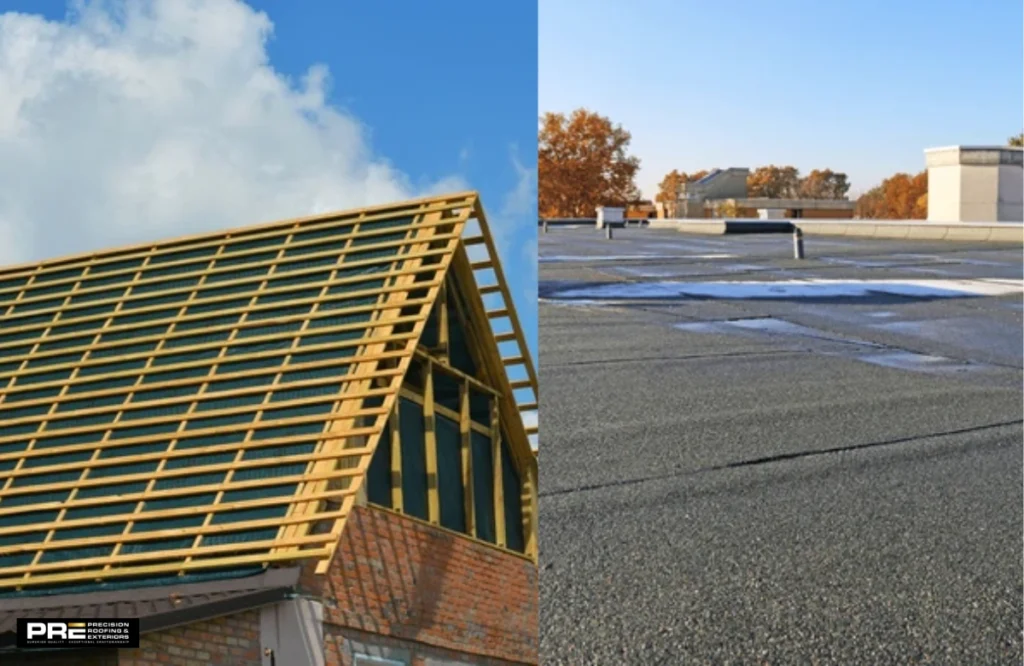Roofs don’t all look the same. Some rise into sharp peaks, catching light and casting long shadows. Others stretch out like a tabletop, wide and nearly level, with just enough tilt to keep water moving. These are pitched roofs and flat roofs. Both protect the home or building beneath, both have their own strengths, and both send a very different message in design. So which roof is better? For homes in harsh weather, pitched roof often win. For businesses or sleek new builds where budget and function matter most, flat makes more sense.
What Is a Pitched Roof?
A pitched roof is the design most people picture when they hear the word “roof.” Angled planes meet at a peak, creating that familiar triangular shape. The slope is more than cosmetic. Water slides away. Snow doesn’t linger. Shingles or tiles can be layered neatly across its surface, forming a shield that holds up for decades.
Homeowners often like pitched roofs because they look settled and permanent. They also create usable space beneath. An attic for storage. A vaulted ceiling that adds height to a room. That extra volume matters. Materials range from asphalt shingles to slate or clay tile, each giving a slightly different personality. And because gravity is doing half the work, pitched roofs rarely struggle with water the way flatter ones do.
What Is a Flat Roof?
A flat roof tells a different story. It isn’t truly flat, though it appears so from the street. Builders add a slight incline, almost invisible, so water drains toward gutters, scuppers, or drains. That subtle slope makes the difference between a strong system and a ponding problem.
You’ll see flat roofs on city blocks, warehouses, shopping centers, and more and more often, modern homes. They’re efficient to construct. Covering wide spans doesn’t take as many materials, which lowers cost. And the top itself isn’t wasted space. HVAC units, solar panels, even a rooftop deck can sit up there. The materials are specialized: membranes like PVC, EPDM, or TPO instead of shingles. Installed correctly, these sheets create a continuous watertight barrier that keeps the building dry year after year.
Comparing Pitched Roofs and Flat Roofs
Neither system is perfect. Each shines in its own way. To see the contrast clearly, it helps to place them side by side:
| Feature | Pitched Roof | Flat Roof |
| Design | Angled, classic, works with many styles | Streamlined, modern, popular in urban builds |
| Drainage | Excellent, gravity does the job | Needs drains or insulation for water control |
| Upfront Cost | Higher, more labor and material | Lower, efficient to build |
| Space | Attics, vaulted ceilings, storage | Rooftop use for equipment or recreation |
| Maintenance | Harder to reach but fewer leak risks | Easy access, inspections more frequent |
| Durability | Long lifespan with shingles, tile, or metal | Membranes durable, but may wear faster in extreme climates |
| Energy Use | Suited for insulation in cold regions | Reflective surfaces reduce heat in warm areas |
Which Is Better?
So, pitched or flat, which deserves the crown? If you live in a climate with heavy snow or constant rain, pitched roofs almost always come out ahead. They channel water effortlessly, last longer, and blend naturally with most residential designs.
But flat roofs bring their own wins. Lower installation costs. Easier access for repairs. More usable square footage on top of the building. For businesses, that extra utility can mean everything. For homeowners chasing a modern aesthetic, it may be exactly what the architecture calls for.
Which is better depends on context. For traditional homes in wet or cold regions, pitched roofs often win. For large commercial spaces or modern houses where efficiency and rooftop function matter, flat roofs hold the advantage.
Conclusion
A pitched roof is angled, classic, and built to shed water with ease. A flat roof is level to the eye, efficient to build, and practical for extra usable space. Both protect, both define a building’s look, and both have clear advantages. So which is better? For most homes in climates with heavy rain or snow, pitched roofs are the safer, longer-lasting option. For businesses and modern homes looking for affordability, efficiency, and flexibility, flat roofs often win the argument.
No matter which you choose, success comes down to installation and upkeep. That is where professional roofing contractors like Precision Roofing proves its value. Our team works with both pitched and flat systems, guiding property owners toward the option that fits best. With the right roof, installed the right way, you are not just covering your building, you are investing in its future.

